Satas D., Tracton A.A. (ed.). Coatings Technology Handbook
Подождите немного. Документ загружается.

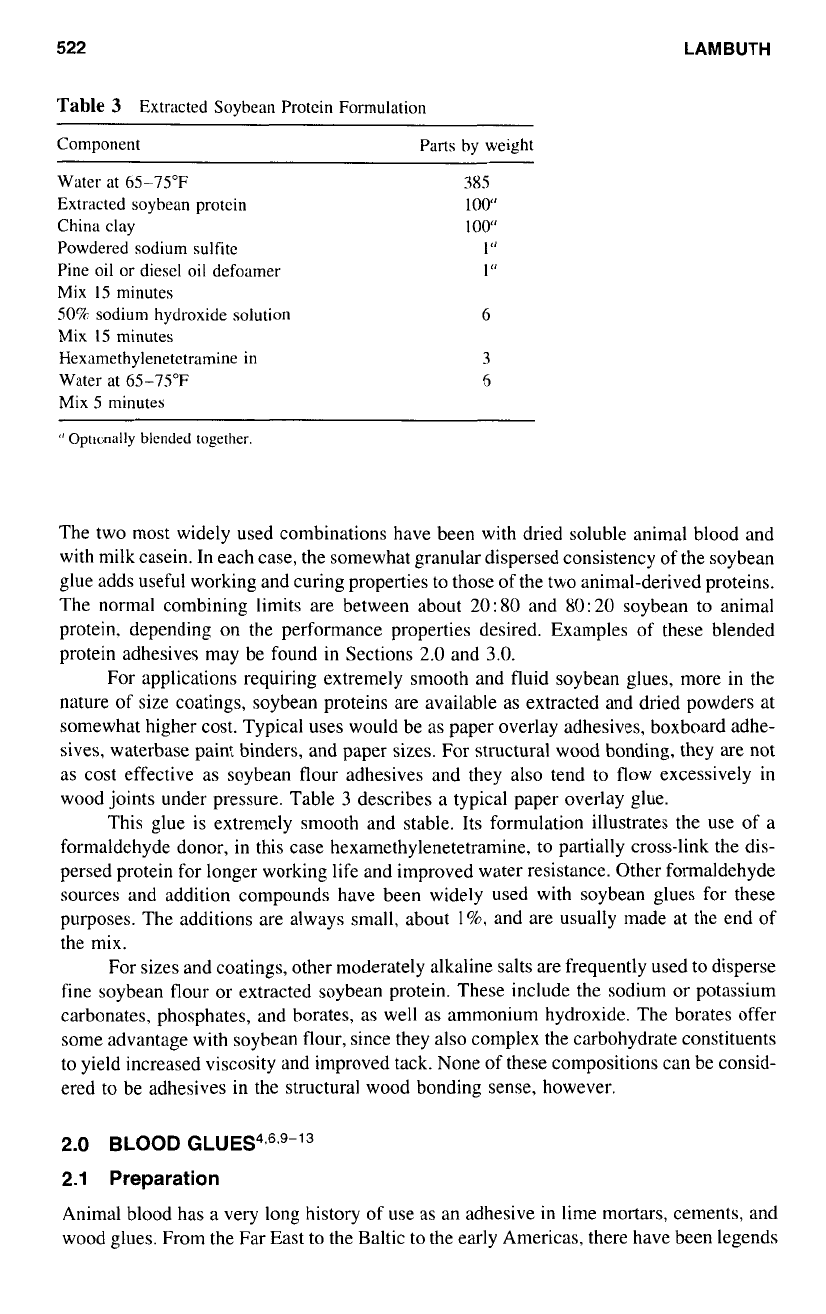
522
LAMBUTH
Table
3
Extracted Soybean Protcin Formulation
Component
Parts
by
weight
Water
at
65-75°F
385
Extracted soybean protcin
100"
China clay
100'
Powdered sodium sulfite
I
'l
Pine oil
or
diescl oil defoamer
1
l'
Mix
IS
minutes
S09
sodium hydroxide solution 6
Mix
15
minutes
Hexamethylenetctrarnine
in
3
Water
at
65-75°F 6
Mix
5
minutes
I'
Opttonally
blended together.
The two most widely used combinations have been with dried soluble animal blood and
with milk casein. In each case, the somewhat granular dispersed consistency of the soybean
glue adds useful working and curing properties to those of the two animal-derived proteins.
The normal combining limits are between about 20: 80 and 80: 20 soybean to animal
protein. depending
on
the performance properties desired. Examples of these blended
protein adhesives may be found in Sections 2.0 and 3.0.
For applications requiring extremely smooth and fluid soybean glues, more in the
nature of size coatings, soybean proteins are available
as
extracted and dried powders at
somewhat higher cost. Typical uses would be as paper overlay adhesives, boxboard adhe-
sives, waterbase paint binders, and paper sizes. For structural wood bonding, they are not
as
cost effective as soybean flour adhesives and they
also
tend
to
flow excessively
in
wood joints under pressure. Table 3 describes
a
typical paper overlay glue.
This glue is extremely smooth and stable. Its formulation illustrates the use of
a
formaldehyde donor, in this case hexamethylenetetramine, to partially cross-link the dis-
persed protein for longer working life and improved water resistance. Other formaldehyde
sources and addition compounds have been widely used with soybean glues for these
purposes. The additions are always small, about
l%,
and are usually made
at
the end of
the mix.
For sizes and coatings, other moderately alkaline salts are frequently used
to
disperse
fine soybean flour or extracted soybean protein. These include the sodium or potassium
carbonates, phosphates, and borates,
as
well
as
ammonium hydroxide. The borates offer
some advantage with soybean flour, since they also complex the carbohydrate constituents
to yield increased viscosity and improved tack. None of these compositions can be consid-
ered
to
be adhesives in the structural wood bonding sense, however.
2.0
BLOOD GLUES4,6.9"3
2.1
Preparation
Animal blood has a very long history of use
as
an adhesive in lime mortars, cements, and
wood glues. From the Far East to the Baltic
to
the
early
Americas, there have been legends
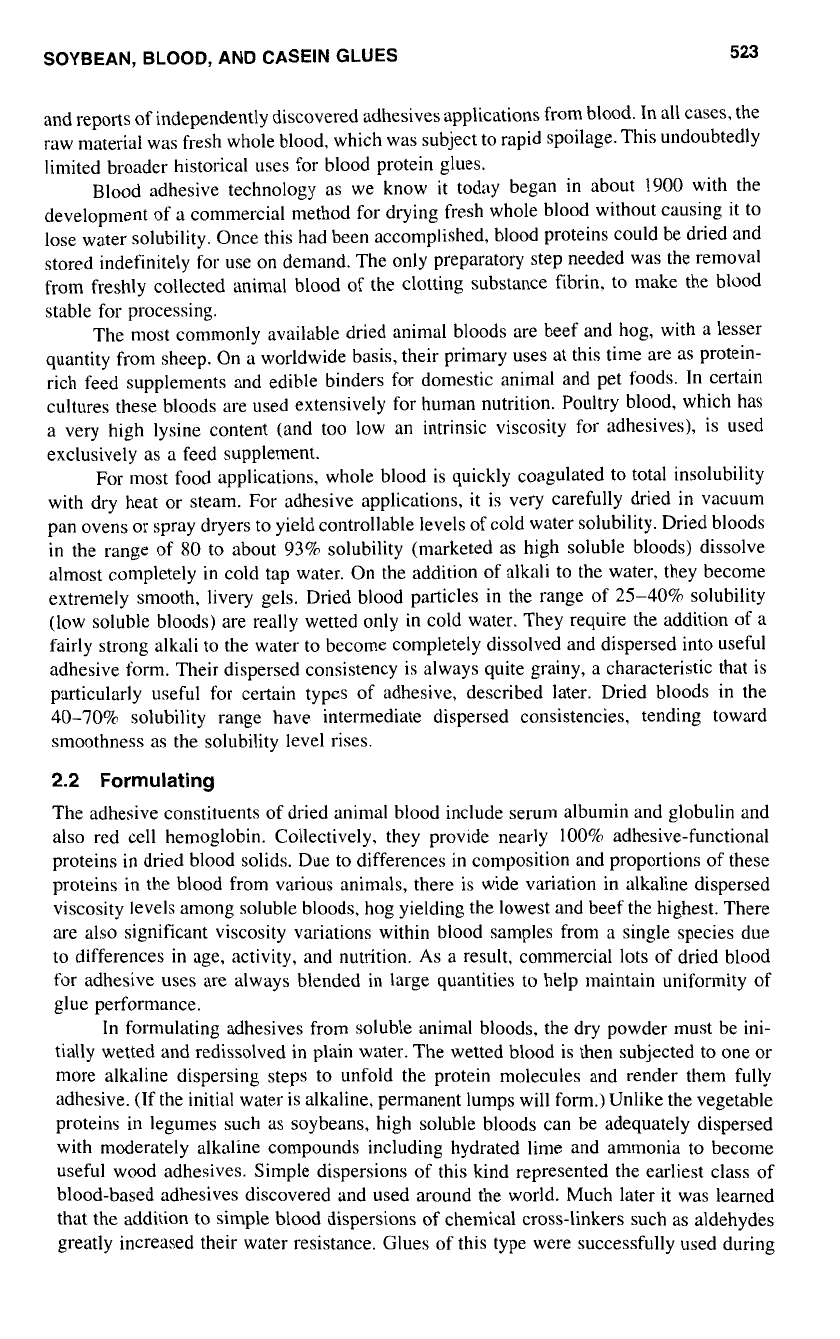
SOYBEAN, BLOOD, AND CASEIN GLUES
523
and reports
of
independently discovered adhesives applications from blood.
In
all Cases, the
raw material was fresh whole blood, which was subject to rapid spoilage. This undoLlbtedly
limited broader historical uses for blood protein glues.
Blood adhesive technology
as
we know
it
today began in about
1900
with the
developn1ent
of
a comn1ercial method for drying fresh whole blood without causing it to
lose water solubility. Once this had been accomplished, blood proteins could be dried and
stored indefinitely for use
on
demand. The only preparatory step needed was the removal
from freshly collected animal blood of the clotting substance fibrin. to make the blood
stable for processing.
The most commonly available dried animal bloods are beef and hog, with a lesser
quantity from sheep. On a worldwide basis, their primary uses at this time are as Protein-
rich feed supplements and edible binders for domestic animal and pet foods. In certain
cultures these bloods are used extensively for human nutrition. Poultry blood, which has
a
very high lysine content (and too low an intrinsic viscosity for adhesives), is used
exclusively as a feed supplement.
For most food applications, whole blood is quickly coagulated to total insolubility
with dry heat or steam. For adhesive applications, it
is
very carefully dried in vacuum
pan Ovens or spray dryers to yield controllable levels
of
cold water solubility. Dried bloods
in
the range of
80
to
about
93%
solubility (marketed as high soluble bloods) dissolve
almost completely
in
cold tap water. On the addition
of
alkali to the water, they become
extremely smooth, livery gels. Dried blood particles in the range of
25-40%
solubility
(low soluble bloods) are really wetted only in cold water. They require the addition
of
a
fairly strong alkali to the water
to
become completely dissolved and dispersed into useful
adhesive form. Their dispersed consistency is always quite grainy, a characteristic that is
particularly useful for certain types
of
adhesive, described later. Dried bloods in the
40-7070
solubility range have intermediate dispersed consistencies. tending toward
smoothness
as
the solubility level rises.
2.2
Formulating
The adhesive constituents
of
dried animal blood include serum albumin and globulin and
also
red cell hemoglobin. Collectively, they provide nearly
100%
adhesive-functional
proteins
in
dried blood solids. Due
to
differences
in
composition and proportions of these
proteins in the blood from various animals, there is wide variation in alkaline dispersed
viscosity levels among soluble bloods, hog yielding the lowest and beef the highest. There
are also significant viscosity variations within blood samples from a single species due
to differences in age, activity, and nutrition.
As
a result, commercial lots of dried blood
for adhesive uses are always blended in large quantities to help maintain uniformity
of
glue performance.
In
formulating adhesives from soluble animal bloods, the dry powder must be ini-
tially wetted and redissolved in plain water. The wetted blood is then subjected
to
one or
more alkaline dispersing steps to unfold the protein molecules and render them fully
adhesive. (If the initial water is alkaline, pernlanent lumps will form.) Unlike the vegetable
proteins in legumes such as soybeans, high soluble bloods can be adequately dispersed
with moderately alkaline compounds including hydrated lime and ammonia
to
become
useful wood adhesives. Simple dispersions
of
this kind represented the earliest class of
blood-based adhesives discovered and used around the world. Much later it was learned
that the addition to simple blood dispersions of chemical cross-linkers such as aldehydes
greatly increased their water resistance. Glues
of
this type were successfully used during
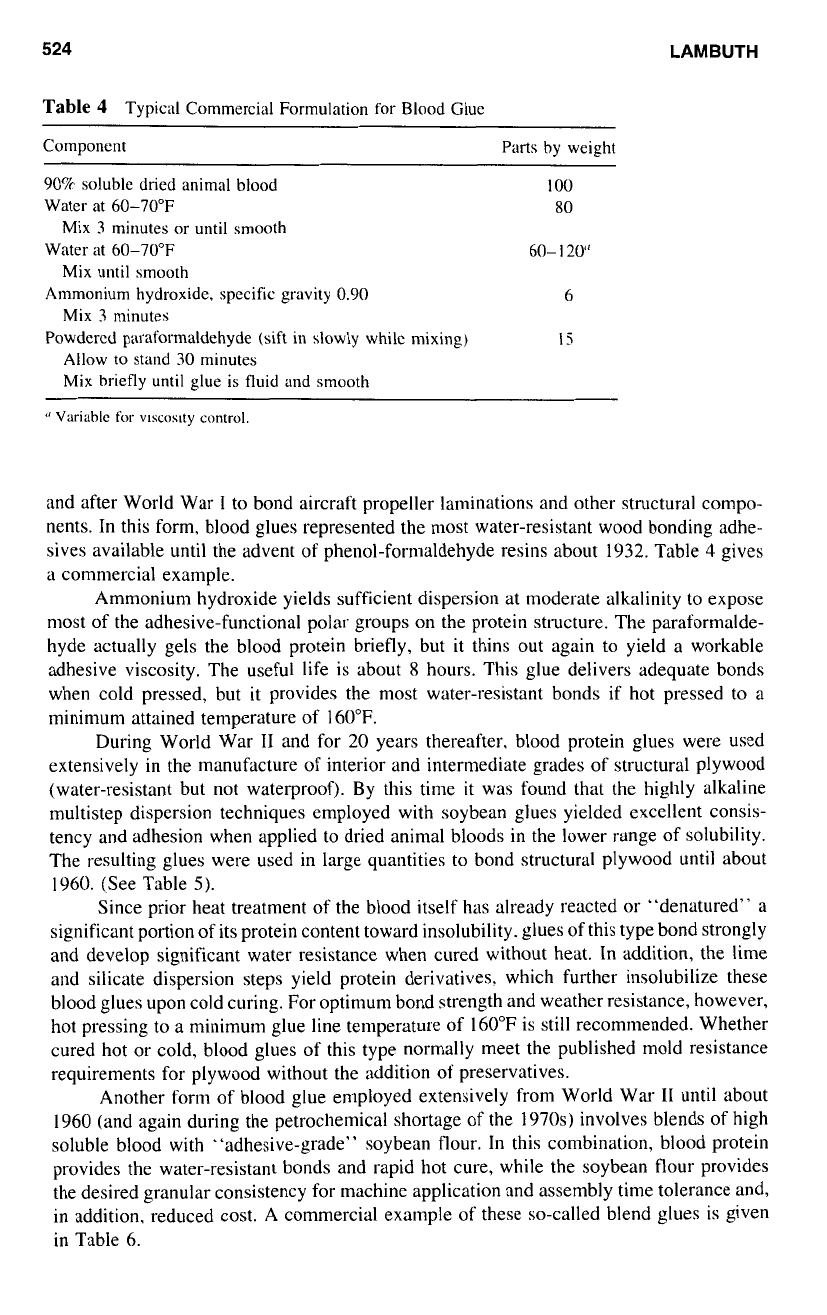
524
LAMBUTH
Table
4
Typical Commercial Formulation for Blood
Glue
Component
~~
Parts by weight
90%
soluble
dried animal blood
100
Water at 60-70°F
80
Water at 60-70°F 60-
120“
Ammonium hydroxide, specific gravity
0.90
6
Powdered paraformaldehyde (sift in slowly while mixing)
1s
Mix
3
minutes or until smooth
Mix
until smooth
Mix
3
minutes
Allow
to
stand
30
minutes
Mix
briefly until glue
is
fluid and smooth
‘‘
Variable
for
v~scos~ty
control.
and after World War
I
to bond aircraft propeller laminations and other structural compo-
nents. In this form, blood glues represented the most water-resistant wood bonding adhe-
sives available until the advent of phenol-formaldehyde resins about
1932.
Table
4
gives
a commercial example.
Ammonium hydroxide yields sufficient dispersion at moderate alkalinity
to
expose
most of the adhesive-functional polar groups
on
the protein structure. The paraformalde-
hyde actually gels the blood protein briefly, but it thins
out
again
to
yield a workable
adhesive viscosity. The useful life is about
8
hours. This glue delivers adequate bonds
when cold pressed, but it provides the most water-resistant bonds
if
hot pressed to a
minimum attained temperature of
160°F.
During World War
I1
and for
20
years thereafter, blood protein glues were used
extensively in the manufacture
of
interior and intermediate grades
of
structural plywood
(water-resistant but not waterproof). By this time
it
was found that the highly alkaline
multistep dispersion techniques employed with soybean glues yielded excellent consis-
tency and adhesion when applied to dried animal bloods in the lower range of solubility.
The resulting glues were used in large quantities
to
bond structural plywood until about
1960. (See Table
5).
Since prior heat treatment
of
the blood itself has already reacted or “denatured” a
significant portion
of
its protein content toward insolubility, glues
of
this type bond strongly
and develop significant water resistance when cured without heat. In addition, the lime
and silicate dispersion steps yield protein derivatives. which further insolubilize these
blood glues upon cold curing. For optinlum bond strength and weather resistance, however,
hot pressing to a minimum glue line temperature
of
160°F
is still recommended. Whether
cured hot or cold, blood glues of this type normally meet the published mold resistance
requirements for plywood without the addition of preservatives.
Another form of blood glue employed extensively from World War
I1
until about
1960
(and again during the petrochemical shortage
of
the
1970s)
involves blends of high
soluble blood with “adhesive-grade” soybean flour.
In
this combination, blood protein
provides the water-resistant bonds and rapid hot cure, while the soybean flour provides
the desired granular consistency for machine application and assembly time tolerance and,
in addition. reduced cost. A commercial example of these so-called blend glues
is
given
in Table 6.
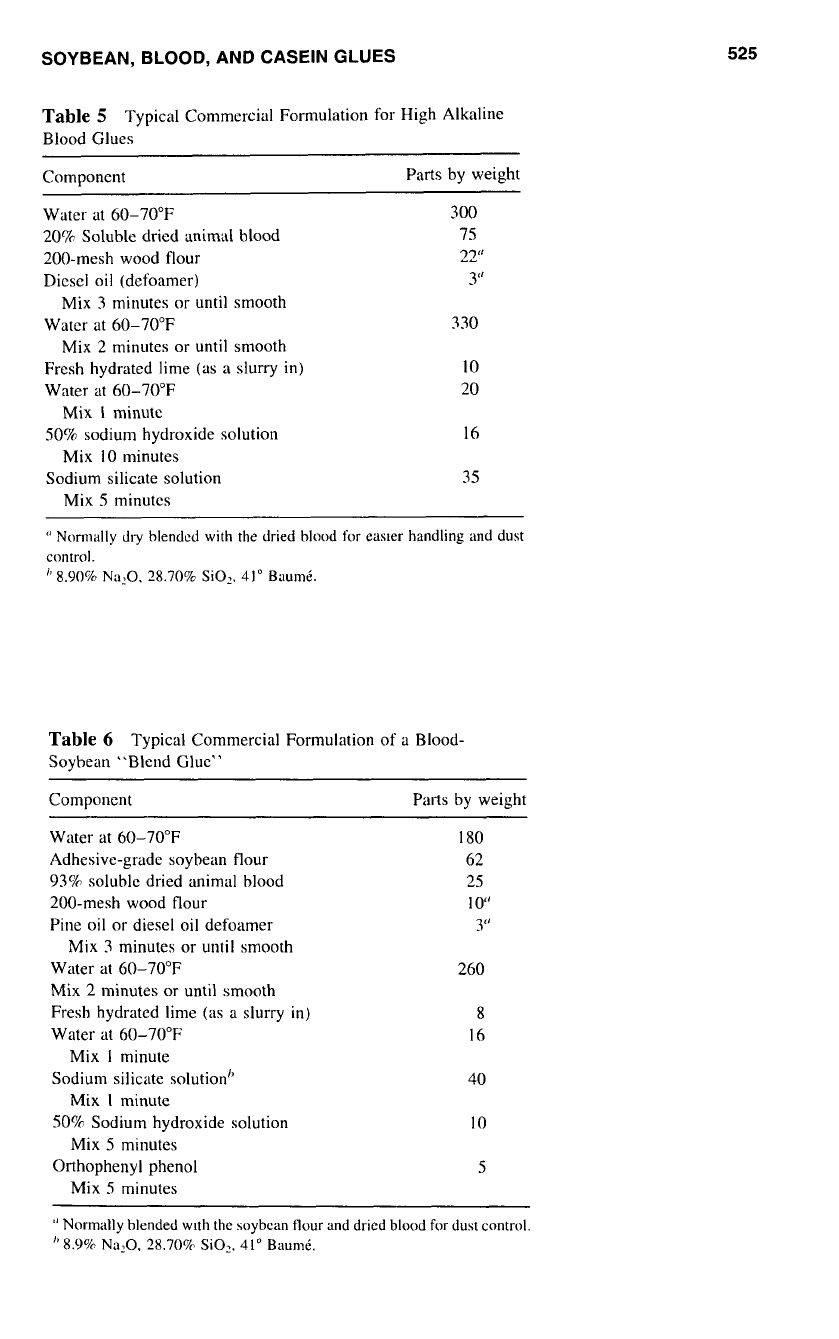
SOYBEAN, BLOOD, AND CASEIN GLUES
525
Table
5
Typical Commercial Formulation for High Alkaline
Blood Glues
ComDonent Parts by weight
~
Water at 60-70°F
20%
Soluble dried animal blood
200-mesh wood flour
Diesel oil (defoamer)
Water at 60-70°F
~~ ~
Mix
3
minutes or until smooth
Mix 2 minutes or until smooth
Fresh hydrated lime (as
a
slurry in)
Water at 60-70°F
Mix
I
minute
50%
sodium hydroxide solution
Sodium silicate solution
Mix
IO
minutes
Mix
S
minutes
300
7s
22”
3‘’
330
IO
20
16
35
‘’
Normally dry blended with the dried blood for easter handling and dust
control.
”
8.90%
Na20. 28.70%
SiO:.
41”
Baumi.
Table
6
Typical Commercial Formulation
of
a Blood-
Soybean “Blend
Gluc”
Component Parts by weight
Water at 60-70°F
Adhesive-grade soybean flour
93%
soluble dried animal blood
200-mesh wood flour
Pine oil
or
diesel oil defoamer
Mix
3
minutes or until smooth
Water at 60-70°F
Mix
2
minutes
or
until smooth
Fresh hydrated lime (as a slurry in)
Water at 60-70°F
Mix
1
minute
Sodium silicate solution”
Mix
I
minute
SO%
Sodium hydroxide solution
Mix
5
minutes
Orthophenyl phenol
Mix
S
minutes
180
62
25
IO
3”
260
8
16
40
IO
S
”
Normally blended wlth the soybean
flour
and dried blood
for
dust control.
”
8.9%
Na20, 28.70%
Si02.
41“
Baumt.
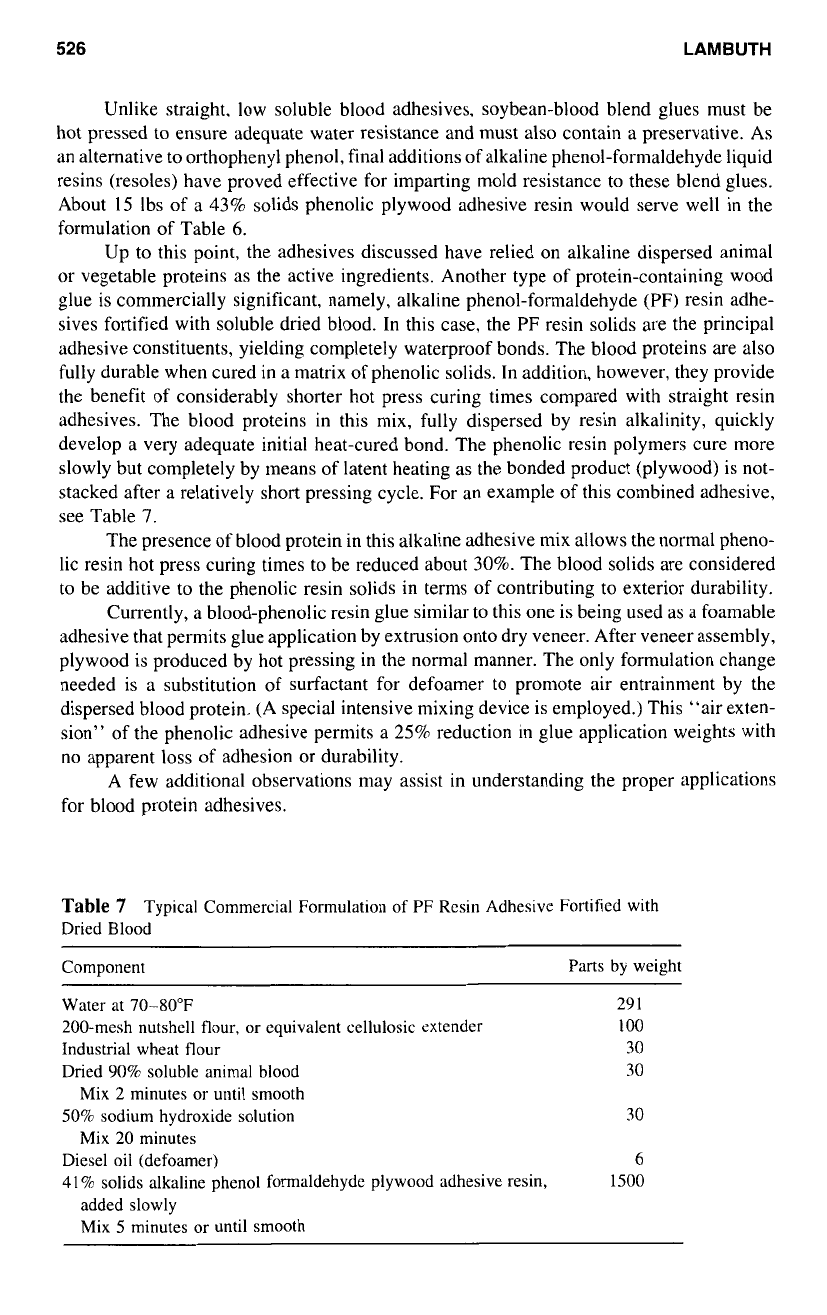
526
LAMBUTH
Unlike straight. low soluble blood adhesives, soybean-blood blend glues must be
hot pressed to ensure adequate water resistance and must
also
contain
a
preservative. As
an alternative to orthophenyl phenol, final additions of alkaline phenol-formaldehyde liquid
resins (resoles) have proved effective for imparting mold resistance to these blend glues.
About 15 Ibs
of
a
43%
solids phenolic plywood adhesive resin would serve well
in
the
formulation of Table
6.
Up to this point, the adhesives discussed have relied on alkaline dispersed animal
or vegetable proteins
as
the active ingredients. Another type of protein-containing wood
glue is commercially significant, namely, alkaline phenol-formaldehyde (PF) resin adhe-
sives fortified with soluble dried blood. In this case, the PF resin solids are the principal
adhesive constituents, yielding completely waterproof bonds. The blood proteins are
also
fully
durable when cured in a matrix of phenolic solids. In addition, however, they provide
the benefit of considerably shorter hot press curing times compared with straight resin
adhesives. The blood proteins
in
this mix, fully dispersed by resin alkalinity, quickly
develop
a
very adequate initial heat-cured bond. The phenolic resin polymers cure more
slowly but completely by means of latent heating
as
the bonded product (plywood) is not-
stacked after
a
relatively short pressing cycle. For an example of this combined adhesive,
see Table
7.
The presence of blood protein in this alkaline adhesive mix allows the normal pheno-
lic resin hot press curing times to be reduced about
30%.
The blood solids are considered
to be additive to the phenolic resin solids in terms
of
contributing
to
exterior durability.
Currently,
a
blood-phenolic resin glue similar to this one is being used as
a
foamable
adhesive that permits glue application by extrusion onto dry veneer. After veneer assembly,
plywood is produced by hot pressing
in
the normal manner. The only formulation change
needed is
a
substitution of surfactant for defoamer to promote air entrainment by the
dispersed blood protein.
(A
special intensive mixing device is employed.) This “air exten-
sion” of the phenolic adhesive permits
a
25%
reduction
in
glue application weights with
no apparent
loss
of
adhesion or durability.
A few additional observations may assist in understanding the proper applications
for blood protein adhesives.
Table
7
Typical Commercial Formulation of PF
Resin
Adhesive Fortificd
with
Dried
Blood
Component Parts
by
weight
Water
at
7040°F
29
1
200-mesh nutshell flour,
or
equivalent cellulosic extender
IO0
Industrial wheat flour
30
Dried
90%
soluble animal blood
30
50%
sodium hydroxide solution
30
Diesel
oil
(defoamer)
6
41
%
solids alkaline phenol formaldehyde plywood adhesive resin,
1500
Mix
2 minutes
or
until
smooth
Mix
20 minutes
added slowly
Mix
5
minutes or
until
smooth
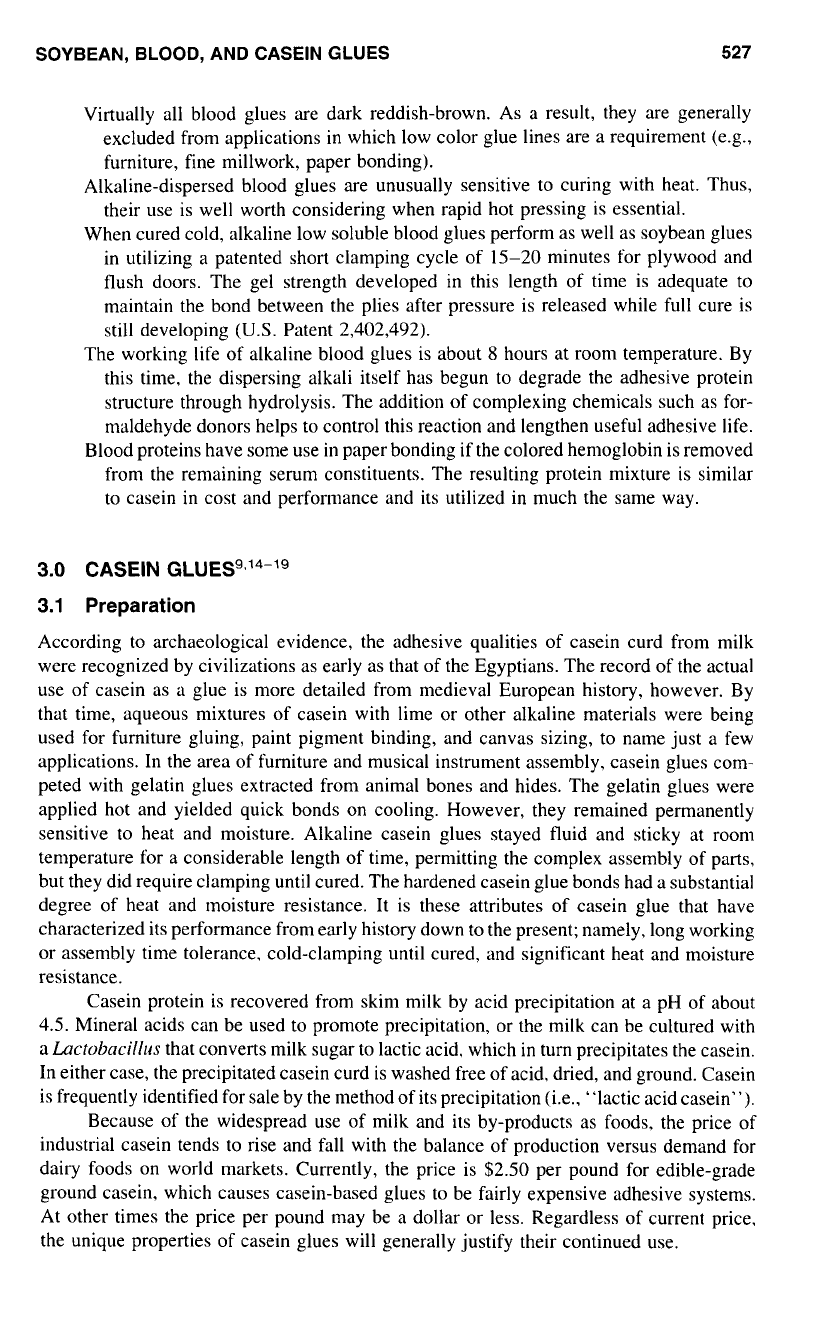
SOYBEAN, BLOOD, AND CASEIN GLUES
527
Virtually all blood glues are dark reddish-brown. As
a
result, they are generally
excluded from applications in which low color glue lines are
a
requirement (e.g.,
furniture, fine millwork, paper bonding).
Alkaline-dispersed blood glues are unusually sensitive to curing with heat. Thus,
their use is well worth considering when rapid hot pressing is essential.
When cured cold, alkaline low soluble blood glues perform as well as soybean glues
in utilizing
a
patented short clamping cycle of 15-20 minutes for plywood and
flush doors. The gel strength developed in this length of time is adequate to
maintain the bond between the plies after pressure is released while full cure is
still developing (U.S. Patent 2,402,492).
The working life
of
alkaline blood glues is
about
8
hours at room temperature. By
this time, the dispersing alkali itself has begun to degrade the adhesive protein
structure through hydrolysis. The addition of complexing chemicals such as for-
maldehyde donors helps to control this reaction and lengthen useful adhesive life.
Blood proteins have some
use
in
paper bonding if the colored hemoglobin is removed
from the remaining serum constituents. The resulting protein mixture is similar
to casein in cost and performance and its utilized in much the same way.
3.0
CASEIN GLUES9~’4”9
3.1
Preparation
According to archaeological evidence, the adhesive qualities of casein curd from milk
were recognized by civilizations as early as that of the Egyptians. The record of the actual
use of casein as a glue is more detailed from medieval European history, however.
By
that time, aqueous mixtures
of
casein with lime or other alkaline materials were being
used for furniture gluing, paint pigment binding, and canvas sizing, to name just a few
applications. In the area of furniture and musical instrument assembly. casein glues com-
peted with gelatin glues extracted from animal bones and hides. The gelatin glues were
applied hot and yielded quick bonds on cooling. However, they remained permanently
sensitive to heat and moisture. Alkaline casein glues stayed fluid and sticky at room
temperature for
a
considerable length of time, permitting the complex assembly of parts,
but they did require clamping until cured. The hardened casein glue bonds had a substantial
degree of heat and moisture resistance. It is these attributes of casein glue that have
characterized its performance from early history down to the present; namely, long working
or assembly time tolerance, cold-clamping until cured, and significant heat and moisture
resistance.
Casein protein is recovered from skim milk by acid precipitation at a pH of about
4.5.
Mineral acids can be used to promote precipitation, or the milk can be cultured with
a
Lacrobacilllrs
that converts milk sugar to lactic acid, which
in
turn precipitates the casein.
In either case, the precipitated casein curd is washed free of acid, dried, and ground. Casein
is frequently identified for sale by the method of its precipitation (i.e., “lactic acid casein”).
Because
of
the widespread use of milk and its by-products
as
foods, the price
of
industrial casein tends to rise and fall with the balance of production versus demand for
dairy foods on world markets. Currently, the price is $2.50 per pound for edible-grade
ground casein, which causes casein-based glues to be fairly expensive adhesive systems.
At other times the price per pound may be a dollar or less. Regardless of current price.
the unique properties of casein glues will generally justify their continued use.
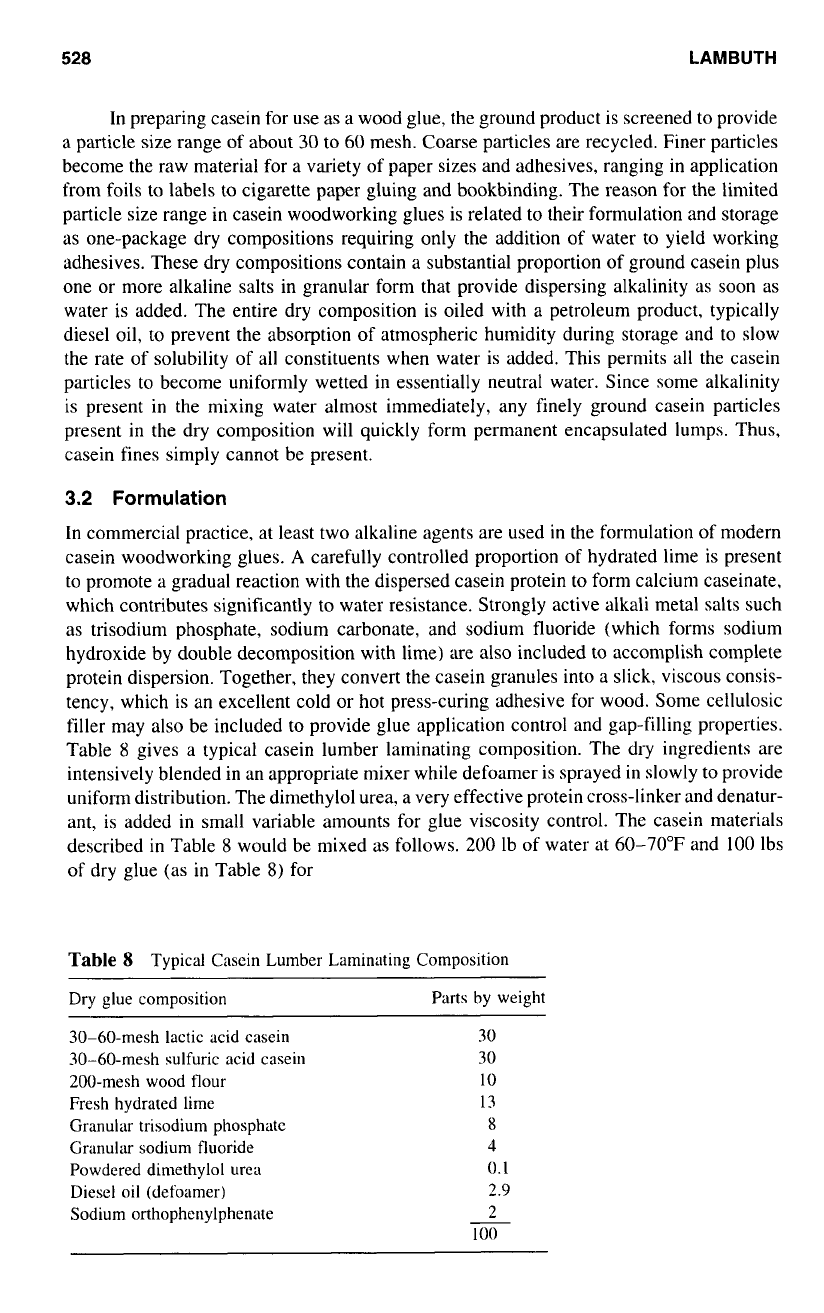
528
LAMBUTH
In preparing casein for use as a wood glue, the ground product is screened to provide
a particle size range of about
30
to 60 mesh. Coarse particles are recycled. Finer particles
become the raw material for a variety of paper sizes and adhesives, ranging in application
from foils to labels to cigarette paper gluing and bookbinding. The reason for the limited
particle size range in casein woodworking glues is related to their formulation and storage
as one-package dry compositions requiring only the addition of water to yield working
adhesives. These dry compositions contain a substantial proportion of ground casein plus
one or more alkaline salts in granular form that provide dispersing alkalinity as
soon
as
water is added. The entire dry composition is oiled with a petroleum product, typically
diesel oil, to prevent the absorption of atmospheric humidity during storage and to slow
the rate of solubility of all constituents when water is added. This permits all the casein
particles to become uniformly wetted in essentially neutral water. Since some alkalinity
is present in the mixing water almost immediately, any finely ground casein particles
present in the dry composition will quickly form permanent encapsulated lumps. Thus,
casein fines simply cannot be present.
3.2
Formulation
In commercial practice, at least two alkaline agents are used in the formulation
of
modern
casein woodworking glues.
A
carefully controlled proportion of hydrated lime is present
to promote a gradual reaction with the dispersed casein protein
to
form calcium caseinate,
which contributes significantly to water resistance. Strongly active alkali metal salts such
as trisodium phosphate, sodium carbonate, and sodium fluoride (which forms sodium
hydroxide by double decomposition with lime) are also included to accomplish complete
protein dispersion. Together, they convert the casein granules into a slick, viscous consis-
tency, which
is
an excellent cold or hot press-curing adhesive for wood. Some cellulosic
filler may also be included to provide glue application control and gap-filling properties.
Table
8
gives a typical casein lumber laminating composition. The dry ingredients are
intensively blended in an appropriate mixer while defoamer is sprayed
in
slowly to provide
uniform distribution. The dimethylol urea. a very effective protein cross-linker and denatur-
ant, is added in small variable amounts for glue viscosity control. The casein materials
described in Table
8
would be mixed
as
follows.
200
lb
of
water at 60-70°F and 100 Ibs
of
dry glue (as in Table
8)
for
Table
8
Typical Casein Lumber Laminating Composition
Dry glue composition
Parts by weight
30-60-mesh lactic acid casein
30-60-mesh sulfuric acid casein
200-mesh wood flour
Fresh hydrated lime
Granular trisodium phosphate
Granular sodium fluoride
Powdered dimethylol urea
Diesel oil (defoamer)
Sodium orthophenylphenate
30
30
1
0
13
8
4
0.1
2.9
2
I00
-
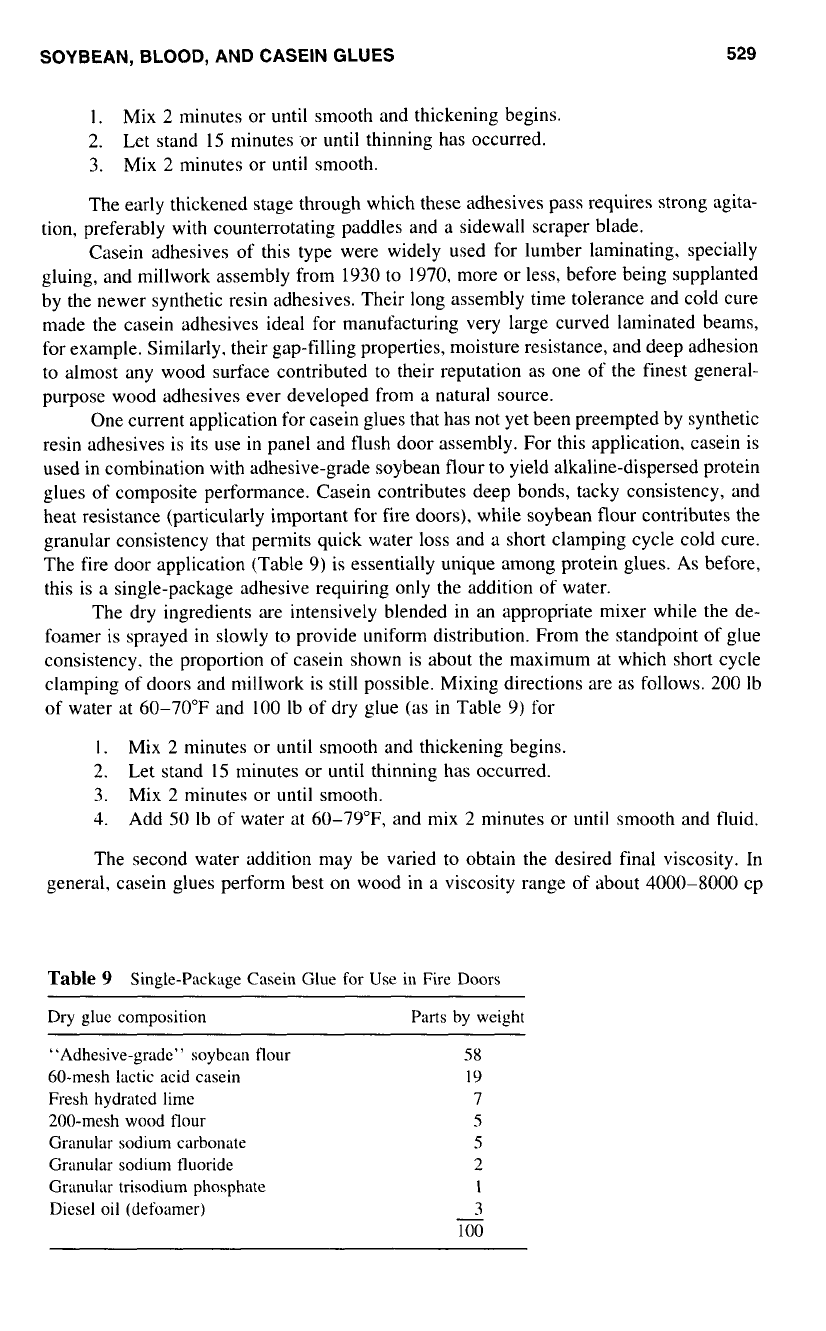
SOYBEAN, BLOOD, AND CASEIN
GLUES
529
1.
Mix
2
minutes or until smooth and thickening begins.
2.
Let stand
15
minutes or until thinning has occurred.
3. Mix
2
minutes or until smooth.
The early thickened stage through which these adhesives pass requires strong agita-
tion, preferably with counterrotating paddles and a sidewall scraper blade.
Casein adhesives of this type were widely used for lumber laminating, specially
gluing, and millwork assembly from 1930
to
1970, more or less, before being supplanted
by the newer synthetic resin adhesives. Their long assembly time tolerance and cold cure
made the casein adhesives ideal for manufacturing very large curved laminated beams,
for example. Similarly. their gap-filling properties, moisture resistance, and deep adhesion
to almost any wood surface contributed
to
their reputation
as
one of the finest general-
purpose wood adhesives ever developed from a natural source.
One current application for casein glues that has not yet been preempted by synthetic
resin adhesives is its use
in
panel and flush door assembly. For this application, casein is
used in combination with adhesive-grade soybean flour to yield alkaline-dispersed protein
glues
of
composite performance. Casein contributes deep bonds, tacky consistency, and
heat resistance (particularly important for fire doors). while soybean flour contributes the
granular consistency that permits quick water
loss
and a short clamping cycle cold cure.
The fire door application (Table 9) is essentially unique among protein glues. As before,
this is a single-package adhesive requiring only the addition of water.
The dry ingredients are intensively blended in an appropriate mixer while the de-
foamer is sprayed in slowly
to
provide uniform distribution. From the standpoint of glue
consistency. the proportion of casein shown is about the maximum at which short cycle
clamping of doors and millwork is still possible. Mixing directions are
as
follows.
200
Ib
of
water at 60-70°F and 100 Ib
of
dry glue
(as
in Table 9) for
I.
Mix
2
minutes or until smooth and thickening begins.
2.
Let stand
15
minutes or until thinning has occurred.
3.
Mix
2
minutes or until smooth.
4.
Add
50
Ib of water at 60-79”F, and mix
2
minutes or until smooth and tluid.
The second water addition may be varied to obtain the desired final viscosity. In
general. casein glues perform best
on
wood in a viscosity range
of
about 4000-8000 cp
Table
9
Single-Package Casein Glue for Use in Fire Doors
Dry glue composition
Parts
by weight
“Adhesive-grade” soybean flour
60-mesh lactic acid casein
Fresh hydrated lime
200-mesh wood flour
Granular sodium carbonate
Granular sodium fluoride
Granular trisodium phosphate
Diesel oil (defoamer)
S8
19
l
S
S
2
I
3
100
-
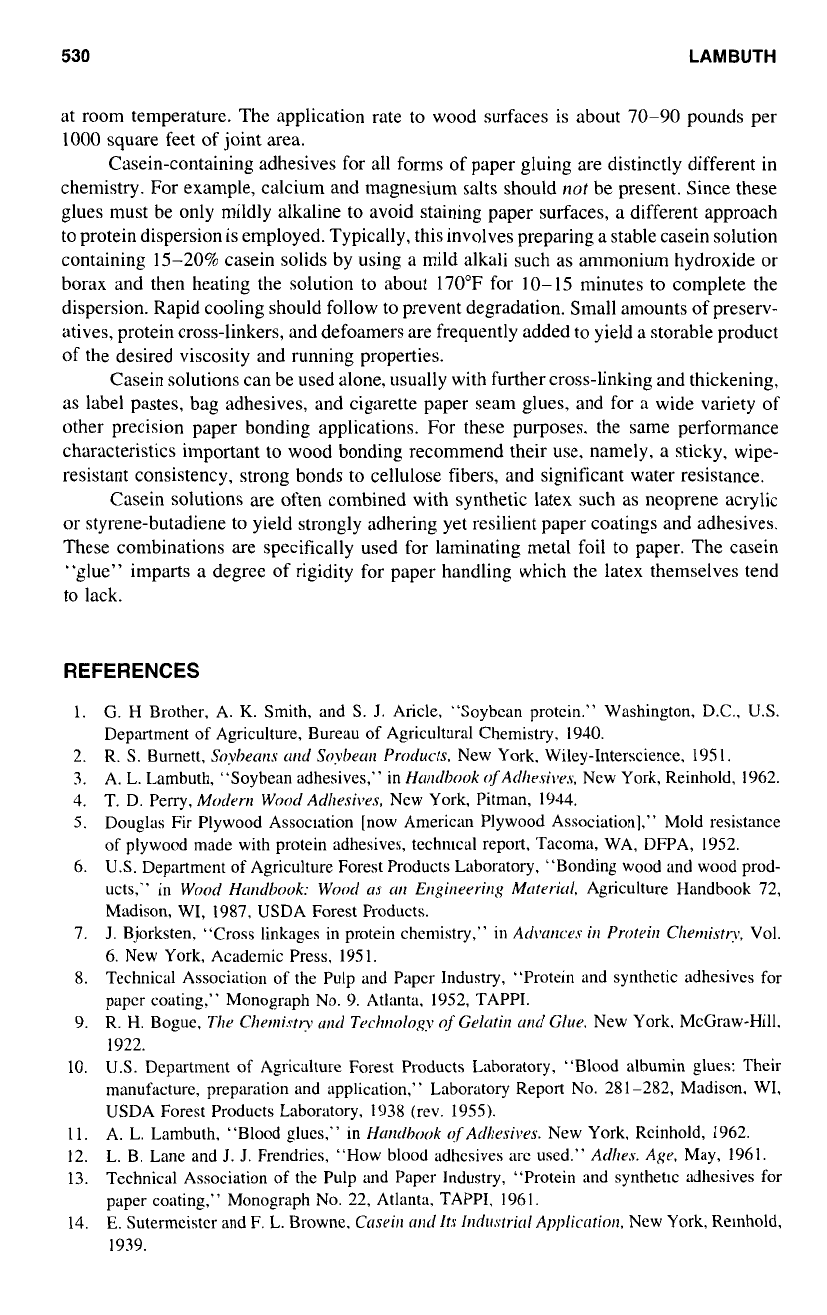
530
LAMBUTH
at room temperature. The application rate to wood surfaces is about
70-90
pounds per
1000 square feet
of
joint area.
Casein-containing adhesives for all forms of paper gluing are distinctly different in
chemistry. For example, calcium and magnesium salts should
r~of
be present. Since these
glues must be only mildly alkaline
to
avoid staining paper surfaces, a different approach
to
protein dispersion is employed. Typically, this involves preparing a stable casein solution
containing
15-20%
casein solids by using a mild alkali such as ammonium hydroxide or
borax and then heating the solution
to
about 170°F for
10-
15
minutes
to
complete the
dispersion. Rapid cooling should follow to prevent degradation. Small amounts of preserv-
atives, protein cross-linkers, and defoamers are frequently added
to
yield a storable product
of the desired viscosity and running properties.
Casein solutions can be used alone, usually with further cross-linking and thickening,
as label pastes, bag adhesives, and cigarette paper seam glues, and for a wide variety of
other precision paper bonding applications. For these purposes. the same performance
characteristics important to wood bonding recommend their use. namely, a sticky, wipe-
resistant consistency, strong bonds
to
cellulose fibers, and significant water resistance.
Casein solutions are often combined with synthetic latex such as neoprene acrylic
or styrene-butadiene to yield strongly adhering yet resilient paper coatings and adhesives.
These combinations are specifically used for laminating metal foil to paper. The casein
“glue” imparts a degree of rigidity for paper handling which the latex themselves tend
to lack.
REFERENCES
1.
2.
3.
4.
5.
6.
7.
8.
9.
10.
11.
12.
13.
14.
G. H Brother, A.
K.
Smith, and
S.
J.
Aricle, “Soybean protein.” Washington, D.C., U.S.
Department of Agriculture, Bureau of Agricultural Chemistry, 1940.
R.
S.
Burnett,
Sovhenrts
cmd
Soybectr~
Products,
New York, Wiley-Interscience, 195
I.
A. L. Lambuth, “Soybean adhesives,” in
Hrrr~dlmjk
ofAdhesiws.
New York, Reinhold, 1962.
T.
D.
Perry,
Modertl
Wood
Adhesives,
New
York,
Pitman, 1944.
Douglas Fir Plywood Assoclation [now American Plywood Association],” Mold resistance
of
plywood made with protein adhesives,
technical
report, Tacoma, WA, DFPA, 1952.
US. Department
of
Agriculture Forest Products Laboratory, “Bonding wood and wood prod-
ucts,”
in
Wood
Hrmi1)ook:
Wood
NS
(U/
E/qineering
MLIferiul.
Agriculture Handbook 72,
Madison,
WI,
1987, USDA Forest Products.
J.
Bjorksten. “Cross linkages in protein chemistry,” in
Ad\wm~s
it!
Protein Cherni.sfr;v,
Vol.
6.
New York, Academic Press, 1951.
Technical Association of the Pulp and Paper Industry, “Protein and synthetic adhesives for
paper coating.” Monograph No. 9. Atlanta. 1952, TAPPI.
R. H. Bogue,
The
Chertlistn‘
cm1
Techtlology
of
Gelrrfirz
ctrd
Glue.
New York. McGraw-Hill.
1922.
U.S.
Department
of
Agriculture Forest Products Laboratory, “Blood albumin glues: Their
manufacture, preparation and application,” Laboratory Report No. 281 -282, Madison. WI,
USDA Forest Products Laboratory, 1938 (rev. 1955).
A. L. Lambuth. “Blood
glue^,"
in
Hmrlbook
of
Arllw.si\-es.
New York, Rcinhold, 1962.
L. B. Lane and
J.
J.
Frendries, “How blood adhesives arc used.”
Adhe.s.
Age.
May, 1961.
Technical Association
of
the Pulp and Paper Industry, “Protein and synthetlc adhesives for
paper coating,” Monograph No. 22, Atlanta, TAPPI, 1961.
E.
Sutermeister and F.
L.
Browne,
Crrseir~
mrl
Its
/nd[tstrictl
AppIicr~tio/~,
New York, Relnhold,
1939.
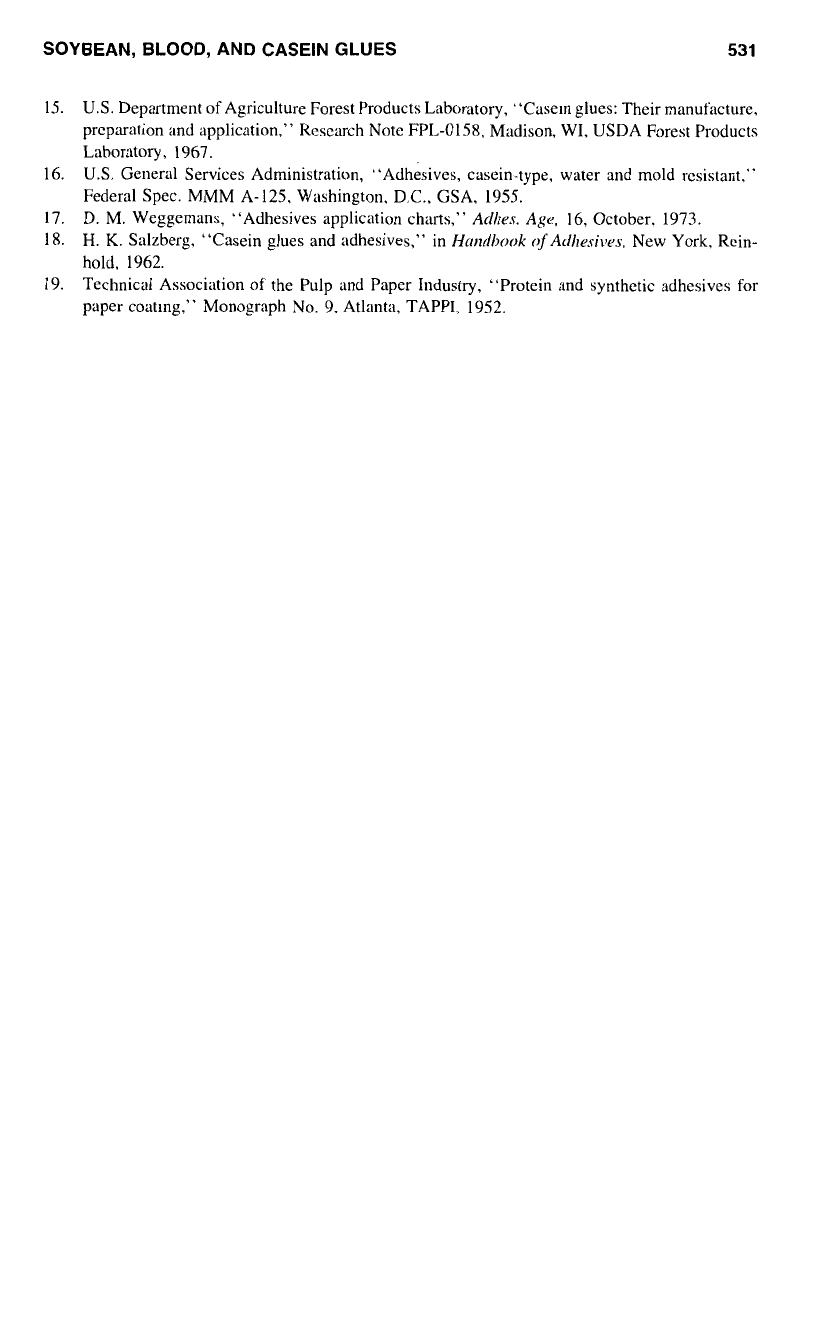
SOYBEAN, BLOOD, AND CASEIN
GLUES
531
15.
U.S. Department
of
Agriculture Forest Products Laboratory, “Caseln glues: Their manufacture,
prcparation and application,” Research Note FPL-0158, Madison, WI, USDA
Forest
Products
Laboratory, 1967.
16.
US.
General Services Administration, “Adhesives, casein-type, water and mold resistant.“
Federal Spec. MMM A-125, Washington. D.C., GSA. 1955.
17.
D.
M. Weggemans, “Adhesives application charts,”
Adhes.
Age.
16,
October. 1973.
18.
H.
K.
Salzberg, “Casein glues and adhesives,” in
Handhook
ofAdlwsives.
New
York,
Rcin-
19. Tcchnical Association of the Pulp and Paper Industry, “Protein and synthetic adhesives
for
hold, 1962.
paper
coating,"
Monograph
No.
9. Atlanta, TAPPI, 1952.
